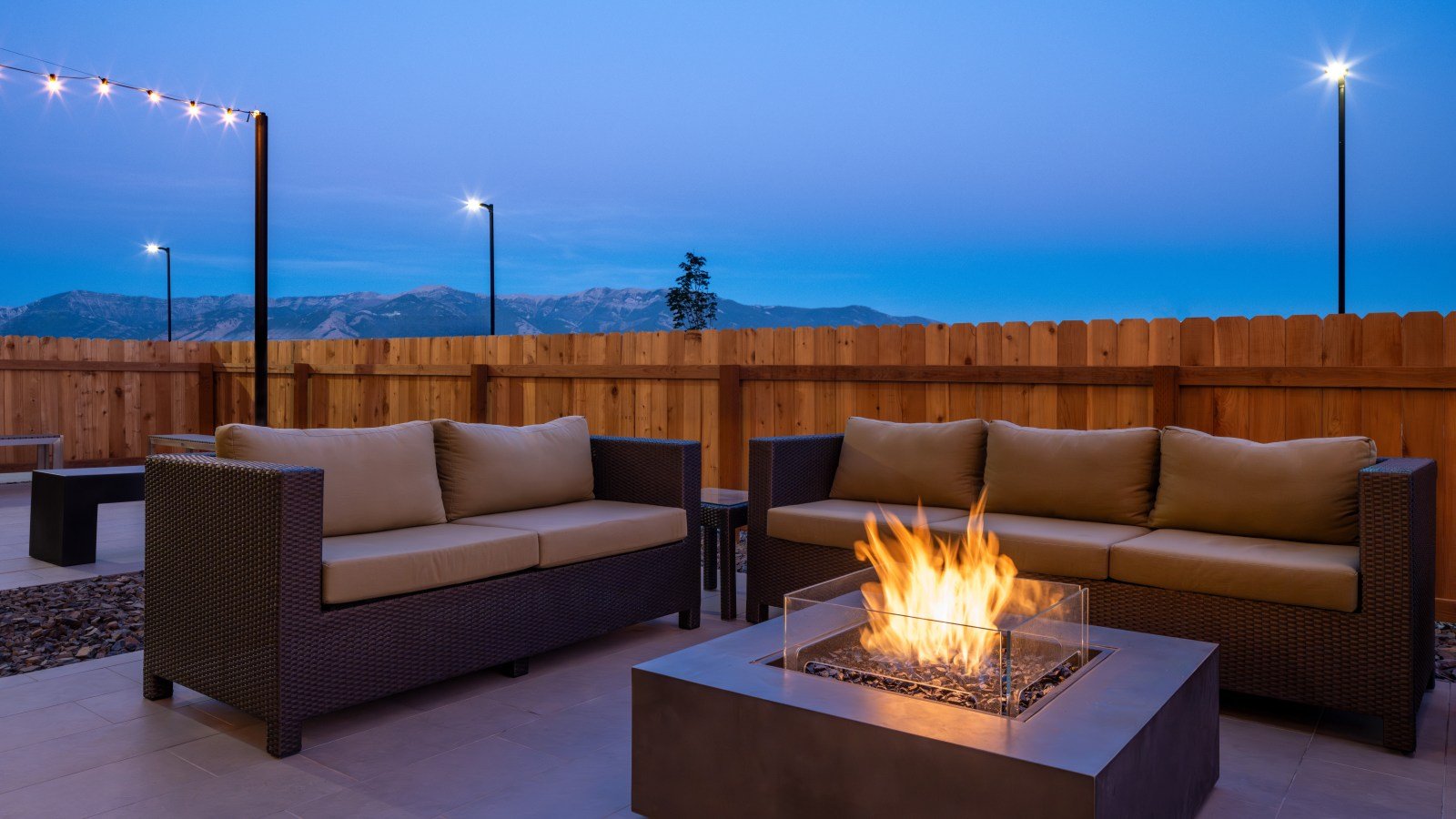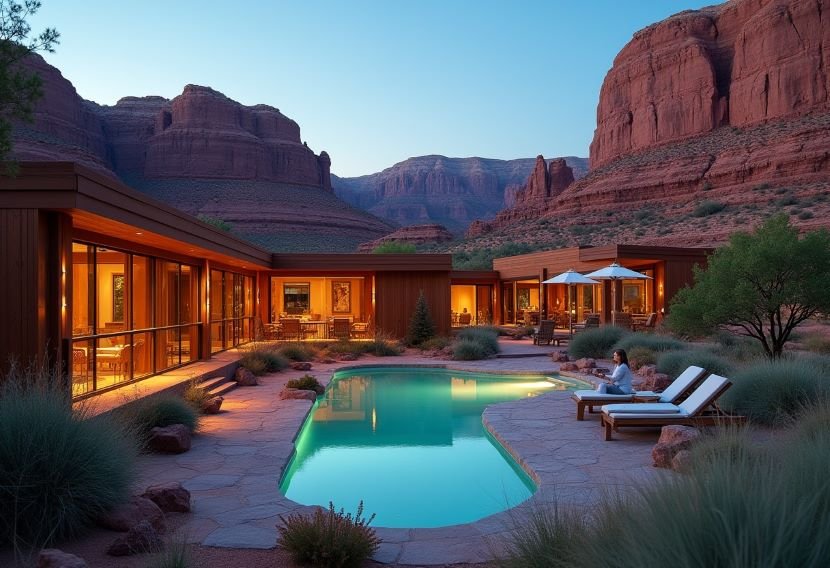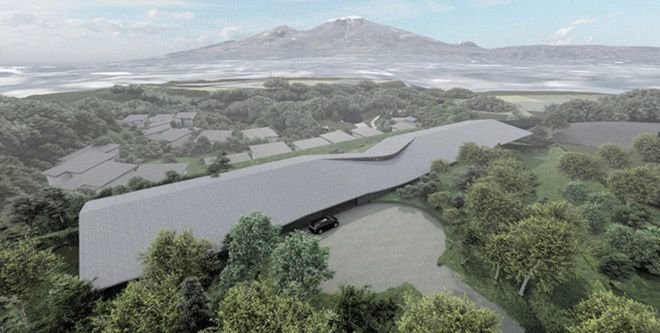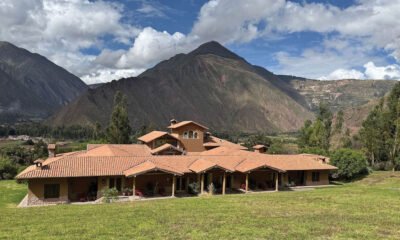Dylan Cross/Dragonfly Image Part
Hotels & Accommodations
The 6 Best Hotels Near U.S. National Parks for 2025

If you purchase an independently reviewed product or service through a link on our website, Rolling Stone may receive an affiliate commission.
These days, you’re probably craving more than just a souvenir T-shirt when you take a trip. More and more travelers are searching for experiences that both challenge and refresh them, which makes the rise of “adventure travel” undeniable. People want to unplug, reconnect with nature, and make memories that don’t fit neatly into an Instagram square (okay, but let’s be honest, we’ll probably post them anyway).
In fact, adventure travel has become one of the fastest-growing sectors of the tourism industry, particularly among Millennials and Gen Z. According to the Adventure Travel Trade Association (ATTA), adventure travel is expected to grow at a CAGR of 16.8% from 2025 to 2030, and according to a 2025 travel trends report by The Future Laboratory and IHG Hotels & Resorts, 68% of Gen Z travelers prefer adventure-based vacations and outdoor experiences.
It’s no surprise, really. After all, who wouldn’t want to swap endless doom scrolling for sunrise canyon views that make you forget your inbox exists? But the thing is, going on your next big adventure doesn’t have to mean sacrificing comfort. With IHG Hotels & Resorts, you can become one with nature without giving up a little bit of luxury, so you can crush that trail you’ve always wanted to hike by day, and return to plush beds and hot showers by night.
IHG has plenty of properties near some of America’s most iconic parks, from California’s towering granite cliffs, to the red rocks of Zion and the soothing springs of Arkansas. So whether you’re road-tripping across state lines or carefully mapping your dream national park tour, these are the five best hotels near national parks so you can be right next to the action (without roughing it).
Picture this: you, your backpack, and giant sequoias so stunning you’ll wonder if you accidentally walked onto a movie set. That’s Yosemite for you! If you’re thinking of hiking to Half Dome, or just want to snap some shots of El Capitan, those landscapes never disappoint.
But after a day of adventuring, you’ll want to recharge somewhere cozy. Holiday Inn Express & Suites in Oakhurst puts you less than 20 minutes from Yosemite’s southern entrance, meaning you’ll have easy access without the hassle of camping gear. Start your morning with the free hot breakfast buffet (don’t miss the cinnamon rolls!), but Oakhurst has some great local dining options that we encourage you to try out too. Treat yourself to a hearty burger or wood-fired pizza before heading back to the hotel and winding down your evening in the heated outdoor pool.
IHG
America’s first national park (and arguably its most famous) Yellowstone is all about raw, untamed beauty. Watch Old Faithful erupt, or spot wolves in Lamar Valley, because no matter where you look, every day here feels like a National Geographic special.
So if you’re dreaming of bubbling geysers and roaming bison, base yourself in the charming town of Cody, known for their nightly summer rodeos and the fascinating Buffalo Bill Center of the West (the town was founded by none other than ol’ Bill himself). Staying at Holiday Inn Cody — Convention Center will put you within a scenic drive that’s under an hour from Yellowstone’s East Entrance, and right in the heart of local Wild West history. After your outdoor escapades, relax in the outdoor heated pool or grab a bite at the on-site restaurant and lounge.
Ron Blunt
Just 90 minutes from Yellowstone’s North Entrance, if you’re looking to adventure hard (then recover right) while exploring Big Sky Country, the brand-new EVEN Hotel Bozeman is ideal for you. Located near the airport in Belgrade, this wellness-focused hotel offers in-room fitness zones (yes, there are yoga mats and even spin bikes!), a 24/7 athletic studio, and a menu is designed to cater to health-conscious diners at EVEN Kitchen & Bar (even the cocktails are organic).
This modern, calming space is a great basecamp whether you’ve been rafting the Gallatin or gone skiing in winter. Need to recharge after a day outdoors? We recommend you take a dip in the indoor pool or gather around the fire pit. Plus, you’re just minutes from the Western charm of Bozeman’s breweries and shops.
IHG
Few places stop you in your tracks quite like the Grand Canyon. Even if you’re just peering over the rim for the first time, the scale and beauty of this natural wonder are jaw-dropping. Experienced hikers know that it’s also worth taking a trek down to those depths.
Located just over an hour from Grand Canyon National Park, voco Flagstaff offers the perfect mix of modern comfort and historic Route 66 charm (and works as a great launch pad for other adventures, if you want to explore Sedona’s red rocks and Meteor Crater, too). This stylish hotel has an easygoing vibe to it with pretty lively social spaces (and some pretty plush bedding, if we do say so ourselves). Flagstaff itself is a gem, packed with cool breweries and clear night skies ideal for stargazing.
IHG
Towering red cliffs and trails that wind through slot canyons — Zion National Park is pure magic. This place will have your jaw dropping with every step as you wade through the Narrows, or hike the iconic Angels Landing (permit required!).
Holiday Inn La Verkin — Zion Park is your ideal basecamp for all this natural beauty, located just 20 minutes from the park’s entrance. Start your day with a hearty complimentary breakfast (me and my father like to see how many Belgian waffles we can stack up), and after your hikes, kick back in the outdoor pool or hot tub. La Verkin and the nearby town of Hurricane also offer some local cafes and stores for stocking up on essentials, especially if you’re visiting on a road trip.
IHG
Looking for something a little different than a 12 mile hike with crazy incline? You’ll want to head to Hot Springs National Park in Arkansas, where relaxation is part of the adventure. Here, natural thermal springs have drawn visitors for centuries, and you can spend your day soaking in historic bathhouses, or boating on nearby Lake Hamilton. The Bathhouse Row is a must-see (eight bathhouse buildings constructed between 1892-1923), and you should also grab a pint at Superior Bathhouse Brewery, where they craft beer from — you guessed it — natural spring water.
The Staybridge Suites Hot Springs offers a peaceful lakeside retreat complete with spacious suites, full kitchens, and an indoor pool. It great for large groups and families, or anyone who likes the idea of whipping up breakfast before a day of soaking in spring-fed bliss.
Why Choose IHG Hotels Near National Parks?
If you love exploring the great outdoors but still want a comfy bed, hot shower, and free Wi-Fi waiting for you at the end of the day, IHG has got you covered. With several convenient locations close to park entrances, you’ll never be too far away from the local attractions and charming towns that surround the parks. Not to mention there’s free breakfast at most locations to fuel your morning adventures without hunting down a cafe (along with other amenities you’ll love, like pools and fitness centers).
And if you sign up for IHG One Rewards, you can also earn points for your stay and redeem them for free nights, gift cards, and more. Sometimes travel plans change too, and that’s why IHG’s Best Flexible Rate makes it easy to book your trip without stressing about the what-ifs. Book your stay whenever you’re ready and cancel for free up to one day prior to your arrival, with no deposit required. So if you’re a meticulous planner (like, several travel Excel spreadsheets-maker) or a spontaneous weekender, your nature escape can fit your schedule. Head over to IHG.com now to explore all the latest offers and start planning your next adventure today.
Hotels & Accommodations
Peru’s Inkaterra hotels offer culture, eco-friendly experiences in a luxe setting.: Travel Weekly

You probably shouldn’t try this at home. There’s no telling how your kitchen will fare — or if you will remain sober.
I refer to the ancient Andean practice of making chicha de jora, or corn beer. The process takes a couple of weeks. The ingredient list is short: yellow corn, flour, herbs, water and a little chicha to kick-start fermentation.
I collected the recipe this spring during a press trip to Peru hosted by that nation’s Inkaterra hotels.
We were guests at the group’s five-star Hacienda Urubamba, in the Sacred Valley of the Incas, when our dance card included chicha-making.
Luxury as a backdrop
Chicha-making is one of several activities included in room rates at Inkaterra properties. The group’s five properties offer adventure/nature/ecofocused experiences against the backdrop of luxury accommodations (near-luxury in the Amazon basin), spa services and some very fine food. Our group stayed at two five-star properties, both Virtuoso members.
The lobby at the Hacienda Urubamba. Photo Credit: Nadine Godwin
• Hacienda Urubamba. This 10-year-old, 40-unit hotel — between Machu Picchu and Cuzco — is 9,776 feet above sea level, providing guests with stunning views of mountains and the Sacred Valley. Several Inca sites are nearby, as are picturesque villages, colorful markets and handicrafts of interest.
The hotel’s architecture mimics a colonial-era hacienda. Design elements — wall hangings, Inca masks, handcrafted woodwork — are inspired by history and local arts. The resulting look is enriched in the dining room and lobby area by floor-to-ceiling windows, reminding visitors again of the area’s beauty.
Hacienda Urubamba’s 100-acre site includes an organic plantation, farmed using traditional hand tools and oxen. It produces New World foods — corn, potatoes and quinoa — ultimately served to guests.
Twenty-eight units are 484-square-foot, stand-alone casitas accessible by foot or a motorized cart operated by staff. Besides terraces with those sweeping views, casitas offer fireplaces, sitting/dining areas, remarkably spacious bathrooms and flat-screen TVs.
Larger than casitas, suites in the main building range from 495 to 958 square feet. For the ultimate in spacious luxury, the hotel combines Suite and Superior rooms to create its Owners Quarters, one at 1,076 square feet accommodating four and another at 2,045 square feet for six.
Even the smallest rooms (258 to 344 square feet) feature sitting/dining areas and terraces. All units receive housekeeping services three times daily and, quaintly, a turndown service with hot water bottle.
The lounge area at the Machu Picchu Pueblo Hotel. Photo Credit: Nadine Godwin
• Machu Picchu Pueblo Hotel. Opened in 1991, this property, at 6,627 feet above sea level, is located in the surprisingly charming little tourist town of Machu Picchu Pueblo.
The hotel layout imitates a village and occupies 12.3 acres of a private preserve in the cloud forest below Machu Picchu Mountain.
The Inkaterra “village” counts 83 whitewashed casitas plus dining halls, spa and lounges, a tea plantation and the world’s largest collection (372 species) of orchid plants. Tea-making is among activities included in room rates, and the property’s tea is served at Inkaterra hotels.
All room types include decor featuring local crafts, a dining area, environmentally friendly toiletries, turndown with hot water bottle plus fireplaces in most cases.
Top of the line are two Villas Inkaterra (3,154 square feet), which come with 24-hour private butler service. The Villas Inkaterra as well as the two Suites Inkaterra (1,894 square feet) and five Suites (1,259 square feet) have heated plunge pools and private gardens.
Chefs emphasize local ingredients, including organic vegetables from the property’s grounds. There are two on-site restaurants, but under the Private Dining program, guests may book private meals in their rooms, in select lobby areas or in the wine cellar.
Conveniently, the hotel is next to the railroad station. Furthermore, guests can walk to the bus that goes to the Machu Picchu archaeological site. For those not trekking, trains are the only way into town. The trains have weight limits, so Inkaterra holds its guests’ larger bags for a convenient pickup after they leave town.
A suite in Inkaterra’s 16th century manor house La Casona, a Relais & Chateau property in Cuzco. Photo Credit: Nadine Godwin
Accolades for Inkaterra
The 50-year-old Inkaterra won U.N. recognition in 2021 as the world’s first climate-positive hotel brand.
Nearly two-thirds of Inkaterra business originates in the U.S. Its properties range from the four-star Hacienda Concepcion in the Amazon basin to the protected 16th century manor house La Casona, a Relais & Chateau property in Cuzco.
La Casona, with 11 suites, is a step back in time, with its classic courtyard, finely carved woodwork and period furnishings. It’s also a door to modern comforts, with a spa, fine dining space, heated floors and smartly outfitted bathrooms. A bonus: It’s a short walk to Cuzco’s main square.
Inkaterra will add a sixth property in Cabo Blanco on the northern coast by early 2026. The inventory also includes two properties operated under a separate brand, named ByInkaterra.
Aside from buffet breakfasts, meals are a la carte. We sampled local specialties — alpaca, guinea pig and quinoa — but ceviche won our hearts. But not just ours: Unesco in 2023 recognized Peruvian ceviche as part of the world’s intangible cultural heritage.
Average rates, based on double occupancy, at Hacienda Urubamba ($600 per night with breakfast) and Machu Picchu Pueblo Hotel ($500 per night with breakfast and dinner) also include on-property activities, tea time, special promotions at cocktail hour, a welcome drink (purple chicha at Urubamba) and 10% tip.
Inkaterra-organized Machu Picchu visits are $150. Other extras include ceremonies overseen by a shaman, which must be booked ahead, and spa services.
Agents can book through a local DMC or directly at sales@inkaterra.com.
Hotels & Accommodations
US Hotel Industry Sees Mixed Performance in Week Ending July, St. Louis Showing Growth Amid Declines

Sunday, August 3, 2025
The latest data from CoStar, a leading provider of real estate analytics, paints a challenging picture for the US hotel industry for the week ending July 26, 2025. Despite recovery signs in certain markets, the overall year-over-year performance indicates slight declines in key metrics such as occupancy, average daily rate (ADR), and revenue per available room (RevPAR). These results reflect a mix of ongoing challenges in the hospitality sector, as well as regional variations across the country.
The overall trend of negative growth in hotel performance for the week compared to the same period in 2024 highlights the ongoing uncertainty facing the industry. However, the report also sheds light on specific markets, such as St. Louis, which recorded positive movement, contrasting the general trend. This article will delve into the details of the data and explore the implications for both hotel operators and travelers.
US Hotel Industry Performance Overview
For the week ending July 26, 2025, the US hotel industry experienced slight declines in all key performance metrics compared to the same week in 2024. The following are the reported figures for occupancy, ADR, and RevPAR:
- Occupancy: 71.5% (-0.7%)
- Average Daily Rate (ADR): $164.88 (-0.1%)
- Revenue per Available Room (RevPAR): $117.88 (-0.8%)
These figures indicate that while the hotel industry continues to experience a relatively strong level of occupancy, the overall revenue generated per available room remains under pressure. The decline in ADR by 0.1% and RevPAR by 0.8% suggests that hotels are still grappling with pricing pressures, particularly as travelers remain cautious about their spending.
Despite the slight year-over-year declines, the overall occupancy rate remains relatively healthy, indicating that demand for hotel accommodations is still stable, albeit with less momentum than in previous periods. However, challenges persist, especially in markets that are struggling to recover from unique regional disruptions.
St. Louis: A Bright Spot Amid the Decline
While many US markets have seen a decline in key performance metrics, St. Louis stands out as a notable exception. The city reported the highest occupancy increase among the Top 25 Markets for the week, with a 5.7% year-over-year rise in occupancy, bringing the rate to 70.9%. This increase can be attributed to a combination of factors, including targeted marketing campaigns, local events, and the city’s growing appeal as a mid-sized destination for both business and leisure travelers.
St. Louis has been positioning itself as a vibrant hub for tourism, with increased efforts to attract more visitors through cultural and recreational offerings. The strong occupancy growth in the city suggests that these efforts are beginning to pay off, as it bucks the overall downward trend seen across much of the US hotel industry.
The performance of St. Louis highlights the importance of localized factors in the hotel industry. While national trends may show overall stagnation or slight declines, specific markets are capable of outperforming the broader trends due to strategic initiatives, favorable local conditions, and the adaptability of hotel operators.
Houston: A Struggling Market
On the opposite end of the spectrum is Houston, which recorded the steepest declines in all three major performance indicators. The city saw a significant drop in occupancy, down by 19.7% to 61.1%. The ADR also fell by 7.7%, reaching $117.02, while RevPAR saw the sharpest decline, down by 25.9% to $71.54.
These declines are primarily attributed to the elevated displacement demand that followed Hurricane Beryl in 2024. Many hotels in Houston experienced a surge in bookings due to the temporary displacement of residents and business travelers during and after the hurricane. As the region returned to normal, this temporary spike in demand was not sustained, leading to a sharp decrease in performance metrics.
Houston’s struggles serve as a reminder of how external factors, such as natural disasters and regional disruptions, can significantly impact hotel performance. As recovery efforts continue, it is essential for operators in affected regions to manage expectations and plan accordingly to regain stable occupancy levels.
Regional Variations and Market Adaptations
The US hotel industry is highly diverse, and performance trends can vary significantly from one region to another. In addition to the notable performances in St. Louis and Houston, other markets are showing mixed results. Cities with strong business travel demand, such as New York and Los Angeles, are likely to continue to perform relatively well, while more leisure-focused destinations might experience fluctuations depending on seasonal trends and consumer confidence.
The key to navigating this complex landscape will be for hotel operators to adapt their strategies based on local demand drivers. With the recovery from the COVID-19 pandemic continuing to evolve, it is crucial for hotels to remain agile, adjusting pricing, marketing, and service offerings to meet changing consumer needs.
Looking Ahead: A Challenging Road for US Hotels
The US hotel industry faces a mixed outlook as it continues to recover from the disruptions of the past few years. While key markets such as St. Louis show promising growth, other cities like Houston are grappling with the aftermath of regional challenges. The slight year-over-year declines in occupancy, ADR, and RevPAR indicate that the road to full recovery will be slow and uneven, with some regions bouncing back more quickly than others.
For hotel operators, the focus must remain on improving efficiency, maintaining high service standards, and responding swiftly to emerging trends. Additionally, keeping track of local market conditions will be vital for adapting to the demands of travelers in a post-pandemic world. As the industry continues to adjust to changing travel patterns, operators will need to stay ahead of the curve by focusing on delivering value to their guests while managing operational costs.
Conclusion
The latest data from CoStar paints a picture of a hotel industry in transition, facing both challenges and opportunities. While national trends indicate slight declines in key performance metrics, specific markets like St. Louis show that targeted strategies and regional initiatives can yield positive results. Meanwhile, cities like Houston remind us that external factors such as natural disasters can have a long-lasting impact on hotel performance.
As the US hotel industry navigates these challenges, the focus must remain on adaptability, efficiency, and customer satisfaction. The ability to respond to local demands and capitalize on emerging trends will be crucial to maintain profitability and sustaining long-term growth. With the hospitality sector continuing to recover, it is clear that the industry is in a period of flux, but the potential for success remains strong in markets that can adjust and innovate effectively.
Hotels & Accommodations
Royal Holdings in tie-up to open 21 luxury hotels in Japan by 2035

Restaurant operator Royal Holdings Co. is teaming up with Minor Hotels, the largest hotel group in Southeast Asia, to develop luxury hotel accommodation in the Japanese market.
The company plans to open 21 hotels across Japan by 2035, targeting wealthy foreign tourists from the more than 36 million people who visit each year.
Based in Thailand, Minor Hotels operates more than 560 luxury hotels and resort facilities in 57 countries.
It is also a member of the Global Hotel Alliance, the world’s largest alliance of independent hotel brands, serving 30 million members.
It will be Minor Hotels’ first foray into Japan.
Royal Holdings and Minor Hotels established a joint venture earlier this year.
On July 10, they unveiled plans to open Anantara Karuizawa Retreat, a hotel and resort facility, in Karuizawa, Nagano Prefecture, in 2030, partnering with general real estate firm List Group.
Anantara is Minor Hotels’ flagship brand.
Situated on a 42,000-square-meter plot overlooking Mount Asamayama, the facility will have 51 guest rooms, of which 23 are suites, It will also boast a spa, swimming pool and restaurants.
The companies are preparing to apply for confirmation for construction.
Accommodation fees and other details have yet to be determined.
William Heinecke, founder and chairman of Minor International, which operates Minor Hotels under its umbrella, told a news conference in Tokyo that Japan is the first choice of overseas destination for Thai people.
He expressed gratitude that the globally recognized hotel brand of Anantara had been accepted in the Japanese market.
Royal Holdings started in-flight catering services and operating a cafe at Fukuoka Airport in 1951.
The company has operated the Royal Host family restaurant chain as well as the Shakey’s pizza chain since the 1970s.
In addition, it operates restaurants at airports, expressway facilities and hospitals, and runs Tenya, a restaurant chain specializing in tempura rice bowls.
As for its hotel business, the company opened its first Roynet Hotel (present-day Richmond Hotel) in 1995. It currently manages 43 Richmond Hotels, which target business travelers.
“We want to operate hotels aimed at wealthy visitors from abroad in tourism destinations and cities around the country as a way to expand the scope of our business,” said Royal Holdings President Masataka Abe.
-

 Brand Stories2 weeks ago
Brand Stories2 weeks agoBloom Hotels: A Modern Vision of Hospitality Redefining Travel
-

 Brand Stories1 week ago
Brand Stories1 week agoCheQin.ai sets a new standard for hotel booking with its AI capabilities: empowering travellers to bargain, choose the best, and book with clarity.
-

 Destinations & Things To Do2 weeks ago
Destinations & Things To Do2 weeks agoUntouched Destinations: Stunning Hidden Gems You Must Visit
-

 Destinations & Things To Do1 week ago
Destinations & Things To Do1 week agoThis Hidden Beach in India Glows at Night-But Only in One Secret Season
-

 AI in Travel2 weeks ago
AI in Travel2 weeks agoAI Travel Revolution: Must-Have Guide to the Best Experience
-

 Brand Stories4 weeks ago
Brand Stories4 weeks agoVoice AI Startup ElevenLabs Plans to Add Hubs Around the World
-

 Brand Stories3 weeks ago
Brand Stories3 weeks agoHow Elon Musk’s rogue Grok chatbot became a cautionary AI tale
-

 Asia Travel Pulse4 weeks ago
Asia Travel Pulse4 weeks agoLooking For Adventure In Asia? Here Are 7 Epic Destinations You Need To Experience At Least Once – Zee News
-

 AI in Travel4 weeks ago
AI in Travel4 weeks ago‘Will AI take my job?’ A trip to a Beijing fortune-telling bar to see what lies ahead | China
-

 Brand Stories4 weeks ago
Brand Stories4 weeks agoChatGPT — the last of the great romantics













You must be logged in to post a comment Login